Whoop Strap 2.0 Review: LeBron Wears It, But Should You?
Though it’s expensive, the Whoop Strap is worth the price for actual or would-be athletes who want to maximize performance and minimize illness and injury.
Why you can trust Tom's Guide
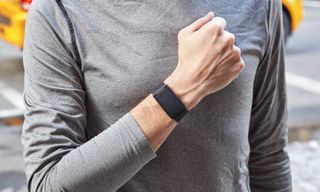
There’s a fitness gadget out there that is so hot that NBA players are sneaking it under their sweatbands, Major League Baseball changed its rules to allow it during games, and high-profile athletes such as LeBron James and Michael Phelps are touting it. It’s now available for the rest of us, too.
The Whoop Strap 2.0 tracks how you are recovering from your last workout, how your sleep is supporting your progress and how ready you are for the workout ahead. However, at $500, it’s not cheap. I took five weeks to find out for myself, as I trained for my 10th marathon, to see if the Whoop lived up to the hype. And it mostly does.
Design: A basic-looking band
The Whoop device has a very simple design. It’s an inch-wide, curved piece of plastic, about 0.5 inches at its thickest. Made to be worn on the wrist, it comes with a black nanostretch band (other color options are available). It doesn’t stand out, and it slips easily under a dress shirt. In fact, I often forgot I was wearing it.
This wearable is waterproof in depths of up to 10 to 20 meters (33 to 66 feet).I wore it in the shower daily, as Whoop encourages you to wear the device 24/7. Ryan Lochte and Michael Phelps wore it while training for the 2016 Olympics, so I’ll take their word that it is OK for swimming, as well.
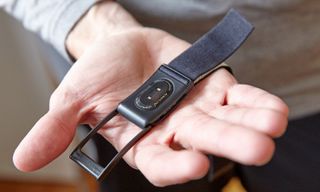
Underneath that unassuming build, there is a lot of activity going on. Every second, the band measures heart rate, heart rate variability (HRV), temperature, motion and whether it is on or off the wrist. This data is synced to the user’s iPhone via Bluetooth (Android compatibility is coming soon) and is used to calculate the three fundamental scores for Whoop: strain, sleep, and recovery.
However, the band lacks a display, so to see any of the data it’s collecting, you have to open the Whoop app on your smartphone. That also means that the Whoop is best used as a supplementary device; runners will still want a GPS watch that can track their route, pace and other metrics.
Strain
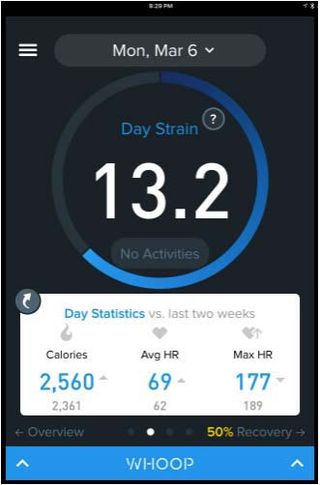
Whoop’s activity score is different from most others. Your strain score, which is based on your heart rate, is a measurement of how difficult the day or a given activity is for you. In other words, if Usain Bolt and I ran the same 100 meters in the same amount of time, I would show a higher strain score than he would because of his physical advantages over my casual running self.
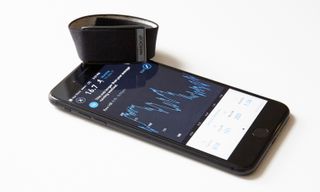
I also noticed that if I was running on less sleep or fighting off a cold, the same run at the same pace would look much harder for me than for a healthier, better-rested me. On the app, you can see the strain score (on a scale of 1 to 21) and a few basic stats around it. On Whoop’s web app, you can see detail over time and compare your strain scores from different activities.
MORE: How to Choose the Right Fitness Tracker for Your Needs
Sleep
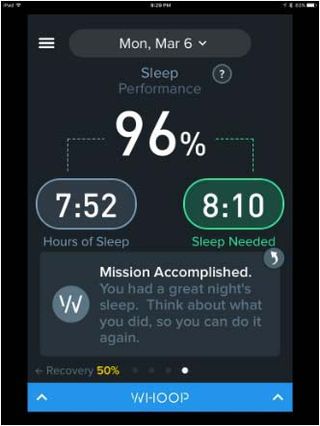
Every morning, Whoop also gives you a sleep score based on how well you slept the night before. It measures this by comparing actual sleep versus needed sleep (which is calculated based on the previous day’s strain). It breaks it down by time in bed,sleep latency (time you’re in bed but not sleeping), sleep cycles, and disturbances.
I found that I often needed to spend almost an hour extra in bed to get the sleep needed to recover properly. At night, a Sleep Coach in the app advised me when to go to bed, based on my wake-up time and desired performance level for the next day.
MORE: Do Sleep Tracking Devices Really Work?
Recovery
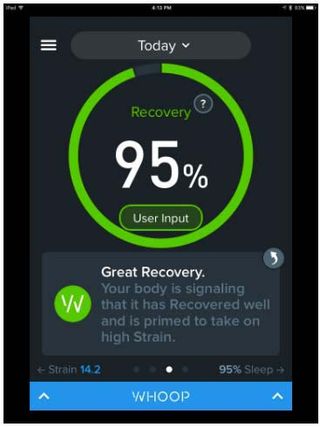
Whoop’s recovery score is what sets this tracker apart. This is the score that tells you how ready you are for a big workout, race or game. The Recovery score is delivered every morning and is based on both resting heart rate and heart rate variability. Heart rate variability measures the variation in the timing of heartbeats. The healthier a heart, the higher this variability.
Based on the recovery score, Whoop suggests high-strain or medium-strain activities, or even dials back the day’s activities. Indeed, on days when I had a high recovery score, I found my running to come easily. Some days when I felt great but had a low recovery score, my easy runs were hard.
I almost got sick, but didn’t
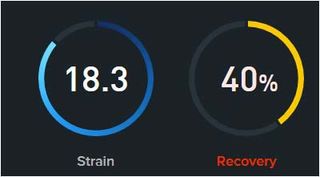
My biggest appreciation for the Whoop came the week I almost got sick. I run five to six days per week, covering 50 to 65 miles, in all kinds of weather, including when it’s in the 50s and sunny, the 30s and raining, and the 20s and snowing, with the wind chill in the single digits. This means it’s easy for me to get run down and sick, especially with colds, which is a common problem not only for runners but athletes of all types.
During my third week of using the Whoop, I noticed that my 8 hours of sleep was not getting me the recovery score that would prime me for a big workout. Secondly, when I went for what I normally consider a fairly easy run, my strain score would show that my body was under tremendous stress.

After two days like this, the web app signaled that my “training may not be sustainable,” and sure enough, I got a little congested. I started to sleep more and minimize my other activities. Normally, I might slough off a little cold, but I respected that Whoop told me to take it easy, so take it easy I did, and likely avoided a full cold that might have come.
MORE: Fitbit Charge 2 Review: This Redesigned Tracker Shines
5K Personal Record

After four weeks with the Whoop, I ran my fastest time ever in a 5K race. In the week leading up to the race, I followed Whoop’s advice for sleeping based on “peaking” the next day. I did this for a few days in a row, until I had a high recovery score on the morning of the race. It gave me the confidence I needed to go out and beat my goal time and achieve a new personal record.

Teams and Coaching
Similar to the social aspects of apps by Fitbit and Garmin, Whoop lets you join a team, so you can compare and compete against friends. I set up a team with a running buddy and could easily tell when he was off his game and quickly became jealous of how his heart health makes him almost always ready for big performances. It’s easy to see why MLB, NBA and Olympic athletes use this device. In an instant, a coach can see who is ready to perform, who needs recovery and who has been out partying all night.
Battery Life
The Whoop’s battery life is advertised as 44 hours. I found this to be accurate, as it would die if I didn’t charge it every other day. I liked that I could charge it during the day while it was on my wrist and I was at work. That way, I didn’t have to worry about missing a workout or sleep readings just to recharge it.
MORE: How Wearing a Fitness Tracker Can Lower Your Insurance
Bottom Line
I must admit I’m hooked on the Whoop. In the morning, I look at my recovery score, which tells me how well I recovered the night before; I use it to determine if I am up for the day’s workout. After my workouts, the app tells me how hard it was for me, regardless of how hard it should have been. At night, I look at it to figure out how much sleep I need to do my best the next day, so I can adjust the time I go to bed. It gives me a perspective on how hard I train, how hard I should train and how I should be recovering.

So, is the Whoop right for you? If you’re a dedicated athlete who wants to not only get the most out of your workouts but also avoid injury and illness, then the $500 Whoop Strap is worth the investment. Just keep in mind that you’ll want a GPS watch as well if you want to keep tabs on your pace, location and stride while you’re out for a run or bike ride. But for me, the Whoop’s holistic look at my health and fitness was a game changer.
Sign up to get the BEST of Tom’s Guide direct to your inbox.
Upgrade your life with a daily dose of the biggest tech news, lifestyle hacks and our curated analysis. Be the first to know about cutting-edge gadgets and the hottest deals.
